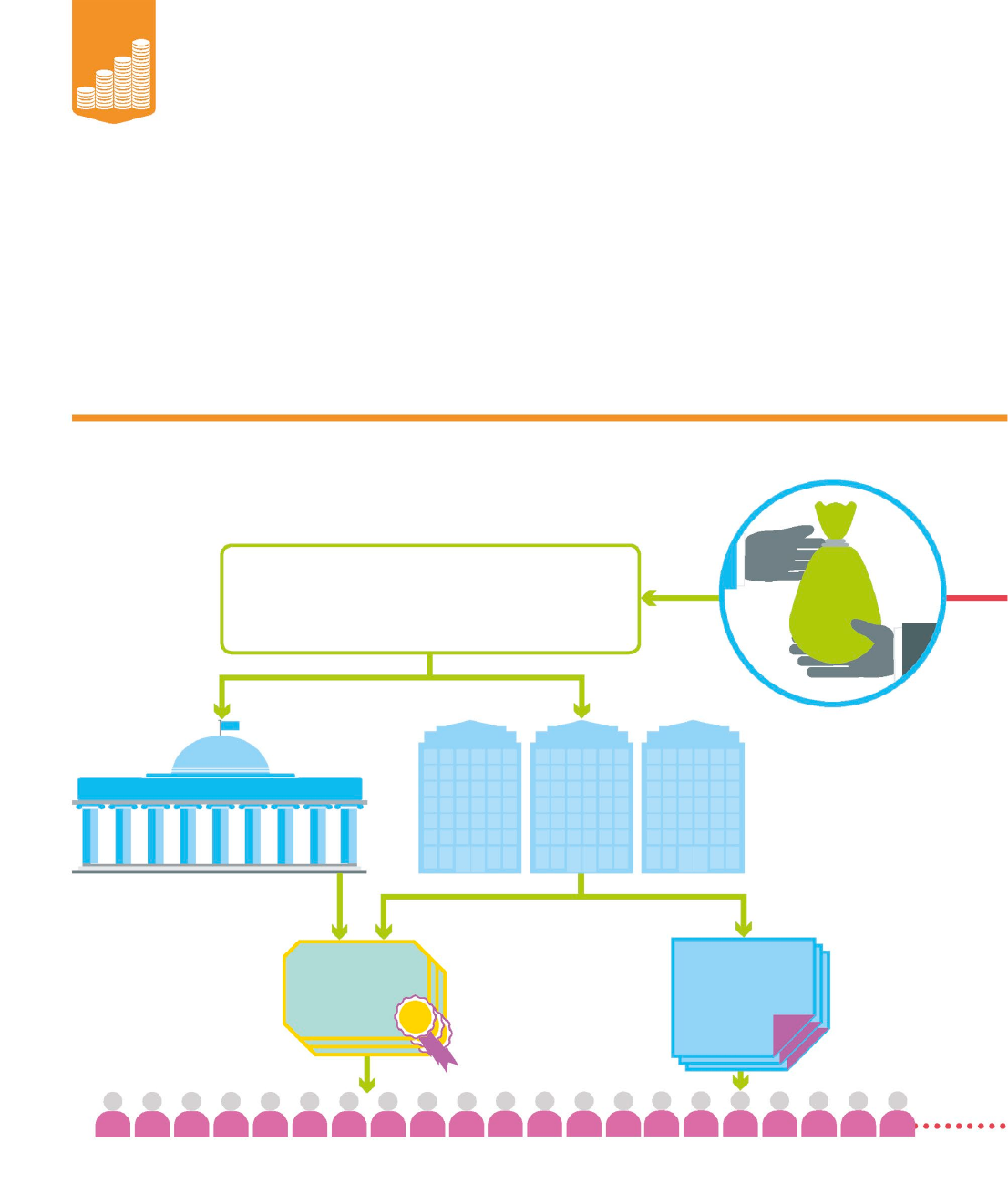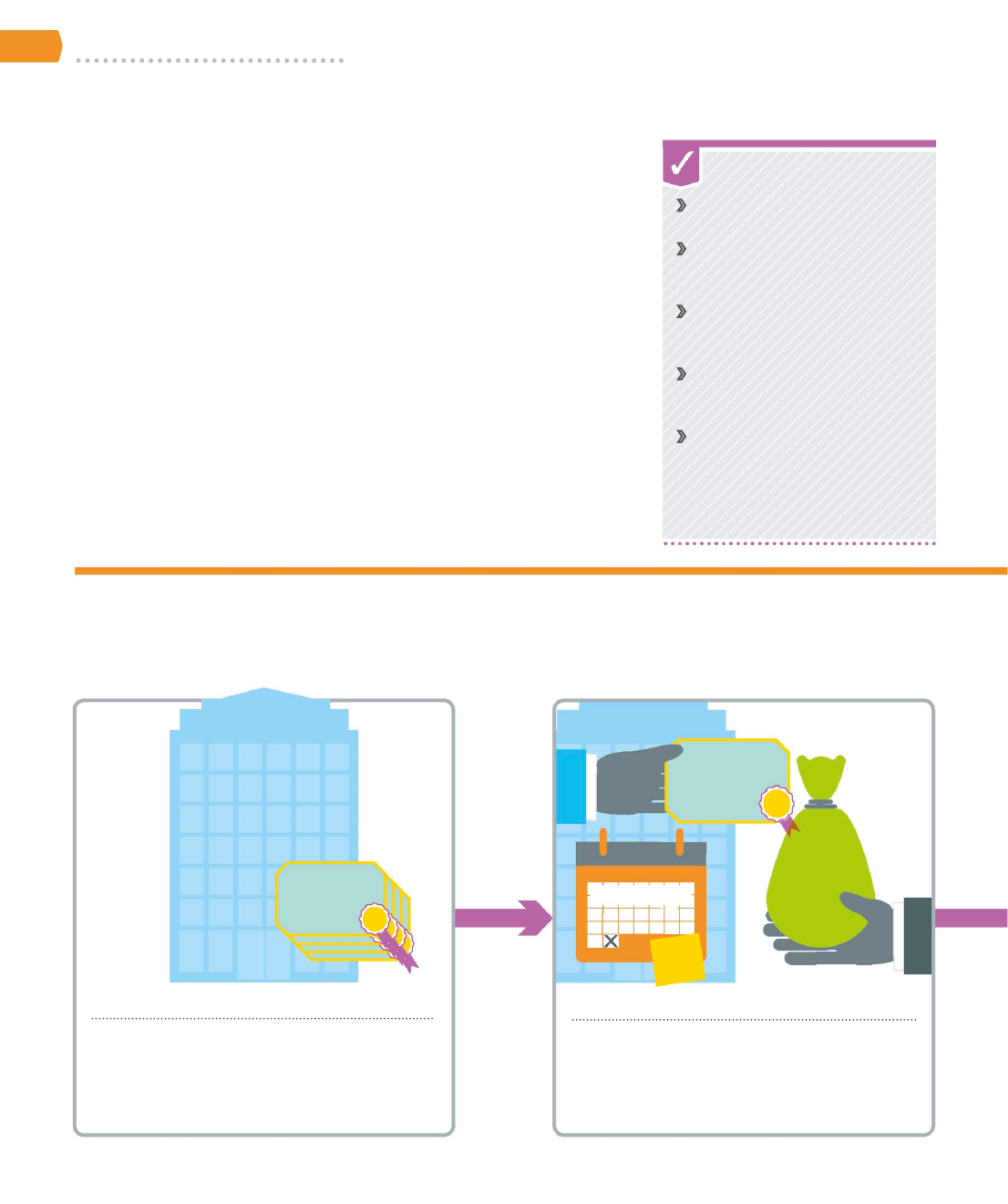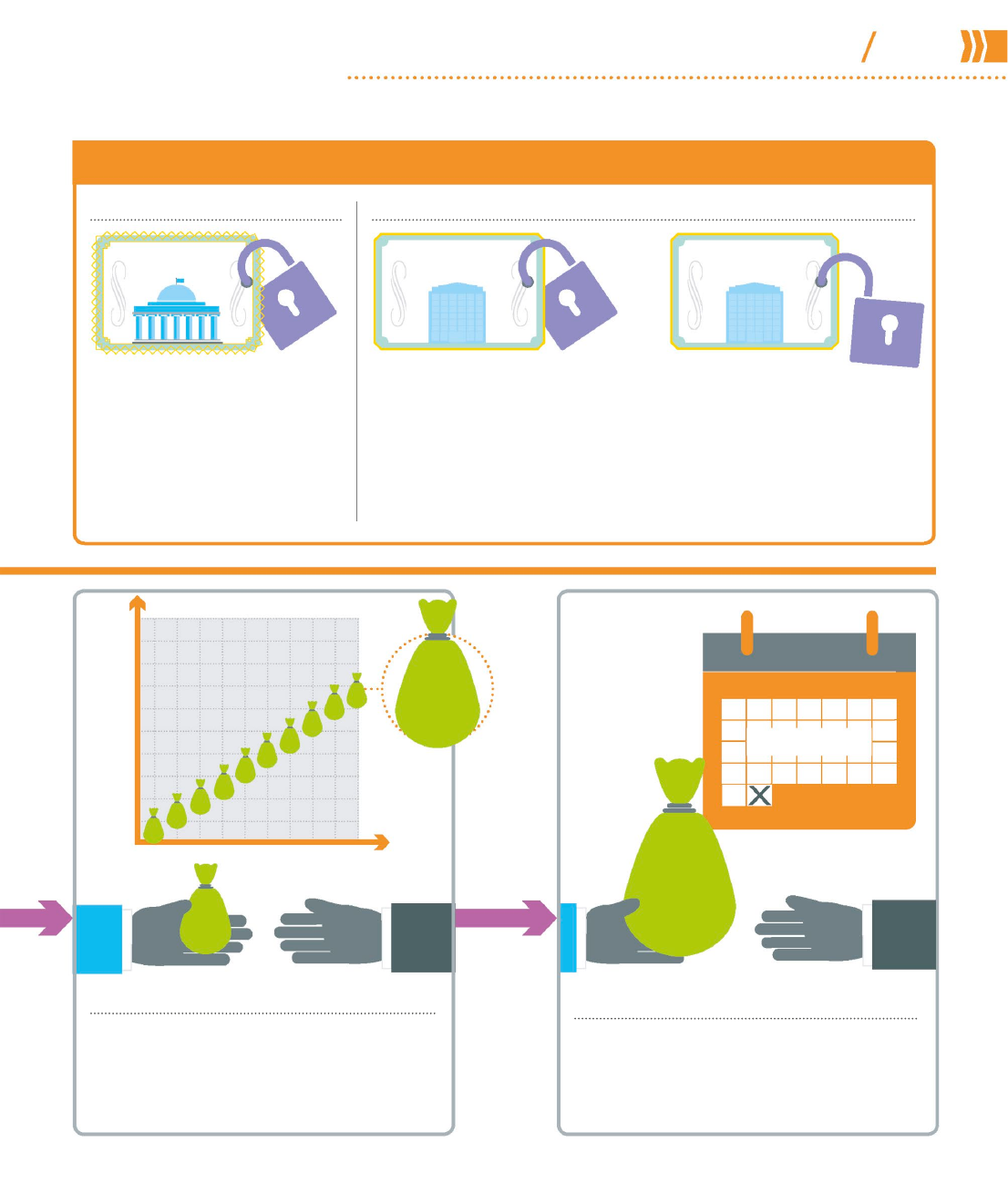
168 169
how finance works
Raising financing
1602
the year the Dutch East
India Company became
the first company to
issue stocks and bonds
When interest rates are low, shares with high dividend
payouts become extremely attractive to investors
because they provide a better return than investments
that yield an interest payment. This economic climate
encourages companies to pay out top-rate dividends
and so attract as many investors as possible, which in
turn increases the share value.
Conversely, when interest rates are rising, investors
may prefer to put their money into fixed-income
assets, which will pay high rates as a result of the hike
without the risk attached to buying shares.
INTEREST RATES AND DIVIDENDS
Making the payment
Most dividends are cash dividends. Sometimes
companies distribute stock dividends, issuing
more shares instead of cash to shareholders.
Paying taxes
Shareholders must
declare dividends on
their tax return and
pay taxes on them.
Keeping funds for growth
The company keeps some of its profit to put back into
the business. It needs to strike a balance between
pleasing investors and expanding its operation.
Investors are
attracted to
pay into
fixed-income
assets, such as
deposit accounts.
Investors are
attracted to
buy shares as
dividends give
a good return
for their money.
HIGH
INTEREST
RATES
LOW
INTEREST
RATES
$
$
$
$
$ $
$
US_168-169_shares_and_dividends.indd 169 21/11/2014 16:24

How it works
There are two types of product sold on the capital
market: shares (equity) and bonds (debt investments).
Shares and bonds are sold first on the primary market,
where they are originally issued, and later traded on
the secondary market. The capital market is crucial
to a functioning economy, because it channels funds
to users of capital, such as businesses and government,
and capital is what enables goods and services to be
produced. The original issuers of the shares and bonds
do not gain from trading activity in the secondary
market, which is purely for investors. However, share
value and bond trading levels reflect confidence in a
company or institution, reinforcing its financial position.
The capital market
The structure
The capital market encompasses the debt capital market,
where bonds are sold, and the stock exchange, where shares
are sold. Both have a primary and a secondary market.
The capital market is a global financial marketplace for trading long-term
securities—bonds with a maturity of at least a year, and shares. It is where
governments and businesses can raise funds and investors make money.
Primary market
The market issues new bonds and shares, with
investment banks overseeing the trading. It is
also known as the new issue market (NIM).
Governments sell bonds
Companies
sell bonds
and sHares
C
a
p
i
t
a
l
m
a
r
k
e
t
bonds
Sold on debt capital
market (bond
market)
$
sHares
Sold on stock
exchange (equity
capital market)
investors
US_170-173_Capital_Market_1-2.indd 170 21/11/2014 16:24
170 171
HOW FINANCE WORKS
Raising financing
Bonds or shares: pros and cons
Secondary market
Investors buy bonds and shares from other investors,
not from issuing companies. The cash proceeds go to
an investor, not to the underlying company or entity.
Individual investors buy and sell
shares and bonds previously issued
on the primary market
SHARES
BONDS
$100
trillion
the estimated value
of global debt markets
C
a
p
i
t
a
l
m
a
r
k
e
t
Bonds (debt investments)
Sellers are contractually obliged to pay interest
Bonds are less risky: debt capital markets are
less volatile than stock exchanges; if the issuing
company has trouble, bondholders are paid
before other expenses and before
compensation to shareholders
Buyers of bonds have no stake in
the company
Buyers cannot access principal sum
until bonds mature
Shares (equity)
Buyers of shares gain a stake in the company
Sellers of shares have to pay dividends,
although these can be reduced or suspended
if the company feels it is necessary
Shares are more risky: changes in company
profits and in the economy as a whole can cause
share prices to rise and fall; if the company fails,
the shares become worthless
A bond is a debt security that
a company issues to investors.
By buying bonds, an investor
is effectively loaning money to
the issuers, who in return agree
to pay interest to the investor.
A bond has a set term of
maturity (a limited number of
years of validity) and until that
time the interest is paid
to the investor annually. When
the bond matures, the issuer
repays the original sum of the
loan to the investor. Companies
or governments issue bonds to
raise money that can then be
put back into the business or
used to fund government.
WHAT IS A BOND?
US_170-173_Capital_Market_1-2.indd 171 21/11/2014 16:24

170 171
HOW FINANCE WORKS
Raising financing
Bonds or shares: pros and cons
Secondary market
Investors buy bonds and shares from other investors,
not from issuing companies. The cash proceeds go to
an investor, not to the underlying company or entity.
Individual investors buy and sell
shares and bonds previously issued
on the primary market
SHARES
BONDS
$100
trillion
the estimated value
of global debt markets
C
a
p
i
t
a
l
m
a
r
k
e
t
Bonds (debt investments)
Sellers are contractually obliged to pay interest
Bonds are less risky: debt capital markets are
less volatile than stock exchanges; if the issuing
company has trouble, bondholders are paid
before other expenses and before
compensation to shareholders
Buyers of bonds have no stake in
the company
Buyers cannot access principal sum
until bonds mature
Shares (equity)
Buyers of shares gain a stake in the company
Sellers of shares have to pay dividends,
although these can be reduced or suspended
if the company feels it is necessary
Shares are more risky: changes in company
profits and in the economy as a whole can cause
share prices to rise and fall; if the company fails,
the shares become worthless
A bond is a debt security that
a company issues to investors.
By buying bonds, an investor
is effectively loaning money to
the issuers, who in return agree
to pay interest to the investor.
A bond has a set term of
maturity (a limited number of
years of validity) and until that
time the interest is paid
to the investor annually. When
the bond matures, the issuer
repays the original sum of the
loan to the investor. Companies
or governments issue bonds to
raise money that can then be
put back into the business or
used to fund government.
WHAT IS A BOND?
US_170-173_Capital_Market_1-2.indd 171 21/11/2014 16:24

THE CAPITAL MARKET
How do bonds work?
Bondholders effectively buy a slice
of a larger loan with each bond, for
which they receive interest, along
with the original sum on maturity.
Issuing, buying, and selling
bonds takes place in the debt
capital market. The marketplace
has several functions: it offers
bonds and other types of loans to
investors; it operates as a fixed-
income market, because the issuer
is required to pay regular interest;
and it enables companies and
governments to raise long-term
funds. Overall, the debt capital
market is much larger than the
stock exchange (equity capital
market), where shares are bought
and sold. It attracts investors
because bonds provide more
protection from risk than shares.
There are various types of bonds,
some safer than others—the risk
lies in whether the issuer will be
able to pay the interest and repay
the principal sum on maturity. A
secured bond is backed by an asset,
such as property; an unsecured
bond is not and so carries more risk.
Both bonds and shares may be
referred to as securities. The term
describes the share or bond itself,
and the certificate of ownership or
creditorship that gives the holder
the right to receive a dividend,
in the case of shares, or interest
payments, in the case of bonds.
BOND
$100
BOND
$100
$100
Company issues bonds
The company issues 1 million bonds at $100 each.
Each bond effectively acts as a loan between the
investor and the company.
Investors buy bonds
Each bond has a set maturity date of 10 years and
a 7 percent interest rate, with a face value of $100.
During the 10 years, the company can use the
money as capital.
Investing in the debt capital market
A company wants to raise $100 million to finance growth but does not wish to
issue further shares. Instead, it raises the money by issuing bonds on the debt
capital market.
NEED TO KNOW
Debt instrument Official term
for bond or other long-term debt
Convertible bond Bond that
can be converted into shares of
the issuing company, or cash
Warrant Security that allows
the holder to buy stock in a
company at a fixed price
Callable bond Bond that
gives the issuer the right to
redeem it before maturity
Non-callable bond Bond
that has no maturity and cannot
be redeemed or sold back to
the issuer, but continues to
provide interest
10 YEARS
7%
interest
US_170-173_Capital_Market_1-2.indd 172 09/11/2016 11:02
172 173
how finance works
Raising financing
Secured
Government bonds are the safest
type of bond since governments
in developed capitalist economies
are unlikely to default on interest
payments on the loan or on the
principal sum.
Secured bonds are secured by the
assets of a company, making them
a less risky investment than shares.
Examples include equipment, trust
certificates, and mortgage bonds.
Unsecured bonds are not
backed by pledged collateral and are
a riskier investment—if the company
fails, investors are paid only after
secured bonds have been paid
out. Because they are more risky,
investors expect a higher return
(interest) on their investment.
Types of bonds
GOVERNMENT
BONDS
SECURED BONDS UNSECURED BONDS
Unsecured
10 YEARS
$100
$7
Investors receive annual interest
Each year, the company pays an investor $7
(7 percent of $100) for each bond bought, in
return for using the principal sum as capital to
fund its business. After 10 years, the investor has
received a total of $70 interest per bond.
Mature bond is repaid
Once the bond reaches its date of maturity, in this
case 10 years, the original sum of money, $100, is
repaid to the investor. So the investor receives a
total of $170, including interest, over the full term,
in return for the original $100 investment.
Secured
Corporate bondsGovernment bonds
0
5 10
YEARS
INTEREST PAID (%)
100
90
80
70
60
50
40
30
20
10
1 2 3 4 6 7 8 9
$70
over 10
years
US_170-173_Capital_Market_1-2.indd 173 21/11/2014 16:24

172 173
how finance works
Raising financing
Secured
Government bonds are the safest
type of bond since governments
in developed capitalist economies
are unlikely to default on interest
payments on the loan or on the
principal sum.
Secured bonds are secured by the
assets of a company, making them
a less risky investment than shares.
Examples include equipment, trust
certificates, and mortgage bonds.
Unsecured bonds are not
backed by pledged collateral and are
a riskier investment—if the company
fails, investors are paid only after
secured bonds have been paid
out. Because they are more risky,
investors expect a higher return
(interest) on their investment.
Types of bonds
GOVERNMENT
BONDS
SECURED BONDS UNSECURED BONDS
Unsecured
10 YEARS
$100
$7
Investors receive annual interest
Each year, the company pays an investor $7
(7 percent of $100) for each bond bought, in
return for using the principal sum as capital to
fund its business. After 10 years, the investor has
received a total of $70 interest per bond.
Mature bond is repaid
Once the bond reaches its date of maturity, in this
case 10 years, the original sum of money, $100, is
repaid to the investor. So the investor receives a
total of $170, including interest, over the full term,
in return for the original $100 investment.
Secured
Corporate bondsGovernment bonds
0
5 10
YEARS
INTEREST PAID (%)
100
90
80
70
60
50
40
30
20
10
1 2 3 4 6 7 8 9
$70
over 10
years
US_170-173_Capital_Market_1-2.indd 173 21/11/2014 16:24
..................Content has been hidden....................
You can't read the all page of ebook, please click here login for view all page.
